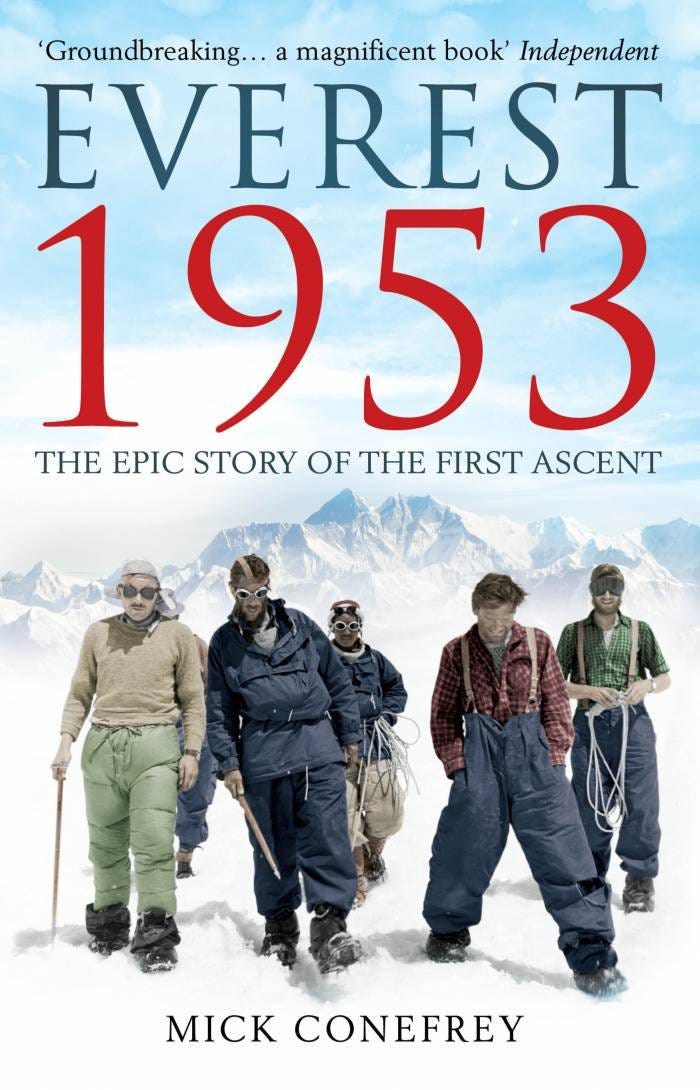Book Review: Everest 1953 by Mick Conefrey
Book 32 of 2025
Mick Conefrey draws on a wealth of documentation from the archives of the Royal Geographical Society and the Alpine Club along with personnel correspondence of the climbers to describe the first successful summiting of Everest. Ed Hillary and Tenzing Norgay are the recognizable names, but there are many more people involved in making the expedition a success. Eric Shipton leads a 1951 reconnaissance trip and expects to receive the nod for the summit attempt, but he is pushed aside in favor of Colonel John Hunt, a British Army officer who served in India and has more Himalayan experience. Hillary is one of several team members unhappy with the change, but Hunt’s leadership and organizational abilities quickly wins over the skeptics.
It takes several weeks for the team to acclimatize and set up the various camps. They require a staggering amount of gear and food. Their experiments with supplemental oxygen add even more baggage to the load. Hunt finds it difficult to hire all the porters they require and they often only stay for a few days at a time. Tenzing is mainly responsible for the 20 climbing Sherpas who are a more dedicated unit. They move pounds upon pounds of equipment on behalf of the climbers so that the men designated for the summit attempt can periodically rest. Who that may be changes from day to day, as the men are struck down with various maladies including frostbite, altitude sickness and dysentery.
Tom Bourdillon and Charles Evans make the first summit push, but turn back due to issues with the closed circuit oxygen sets. Hillary and Tenzing succeed on May 29, 1953. The announcement that the team reached the summit coincides with the day of Queen Elizabeth II’s coronation, leading some people to believe the Everest climb is a hoax. (Fake news!)
Speculation immediately ignites - who really made it first, Tenzing or Hillary? The press adds to the clamor, demanding to know. The men hold a united front for some time, saying it does not matter because neither could have done it without the other. Eventually, Tenzing admits Hillary was first and Hillary confirms it.
Conefrey does an excellent job of methodically laying out the expedition and who is responsible for what. It is a little dry, but the moments of excitement are vast. He bemoans how commercial the climbing of Everest is now, and how the number of permits issued impacts both safety and the environment.
Highlights:
I was shocked at how quickly the accomplishment sank out of public view. Conefrey posited that the decline of the British Empire after World War II was partially to blame.
I enjoyed hearing what happened to the climbers after the expedition ended. More than a couple met a tragic end in another mountain climb.
Criticisms:
The sherpas’ viewpoints are missing apart from Tenzing. This is all too common.
The description of Tenzing and Hillary reaching the summit was strangely anticlimactic. A little more verve would have been nice (although it was an accurate reflection of how exhausted they were).
Rating: 3 stars out of 5. I remain amazed that anyone managed to climb Everest.
Further Reading:
Into Thin Air by Jon Krakauer
Left for Dead by Beck Weathers
Buried in the Sky by Peter Zuckerman and Amanda Padoan
Hidden Mountains by Michael Wejchert



I am impressed by your review!
Great review 😁